
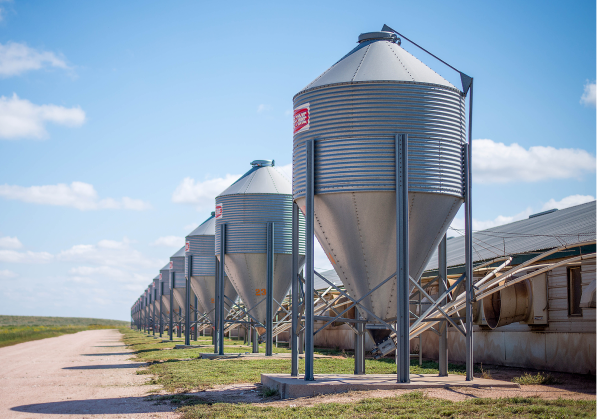
Our Commitment
We hold ourselves to a high standard of responsibility for environmental stewardship, and we continually develop innovative solutions to improve our conservation of precious natural resources. To learn more, view our environment video.
Our Path to Carbon Negative
In 2020, we expanded our previous goal to reduce GHG emissions across our U.S. value chain 25% by 2025, setting even stronger goals to reduce GHG emissions by 30% across our entire U.S. value chain and become carbon negative in all our U.S. company-owned operations by 2030. To affirm our environmental commitments, we joined Business Ambition for 1.5°C, a global campaign in line with the Paris Climate Agreement goals led by the Science Based Targets initiative (SBTi) in partnership with CDP, the United Nations Global Compact, the World Resources Institute and the World Wide Fund for Nature.
Our Approach
For us, environmental stewardship is not just about compliance. It’s about doing what’s right and taking action to reduce the potential impact of our operations on the planet. Our focus is on finding bold, impactful solutions to optimize our supply chain, reduce waste and improve our environmental efficiency.
Environmental Oversight
Our Environmental Management System helps us manage our environmental actions in a comprehensive, systematic and documented approach aligned with International Organization for Standardization (ISO) 14001 standards. All our manufacturing facilities (except new acquisitions and those where certification is not applicable) and all our company-owned farms are ISO 14001:2015-certified. This international standard sets requirements for environmental management systems and helps organizations improve environmental performance through more-efficient use of resources and waste reduction. We also maintain robust, standardized internal auditing systems that ensure consistent environmental compliance across all our operations.
We’ve set an ambitious goal to reduce our greenhouse gas emissions by 30%
Policies and Statements
Efficiency on Our Farms
Waste and Manure Management
We have long viewed manure and the nutrients it contains as valuable resources, and we continue to seek innovative approaches to reduce GHG emissions in our manure management practices. Our partnership with Anuvia™ Plant Nutrients, for example,supplies remnant solids from the bottom of anaerobic lagoons and basins that store and teat manure on our North Carolina farms to enrich SymTRX™, the company’s commercial-grade fertilizer. Our trained environmental technicians also systemically recycle the nutrients in manure as fertilizer to meet the individual nutrient needs of cropland on our farms in strict adherence with regulatory requirements.
We also recycle the nutrients in manure as fertilizer to cropland on our farms. Our trained environmental technicians recycle manure as fertilizer to meet the individual nutrient needs of each of our farms in strict adherence to regulatory requirements.
Water Stewardship
The fragility of the globe’s water resources is increasingly evident, and the need for a coordinated response is increasingly urgent. Our Water Policy underlines our approach to protecting watersheds through quality management, conservation and cooperation with communities where we operate.
On our farms, water is used for pigs to drink and for sanitation, cooling and biosecurity. At our facilities, we use it for cooking and sanitation. As responsible water stewards, we are determined to substantially increase water-use efficiency and ensure sustainable use of this vital resource. Our efforts build on the work we undertook over a decade ago to understand water supplies across our entire footprint and develop stewardship plans through 2025 using the World Business Council for Sustainable Development’s Global Water Tool and the Global Environmental Management Initiative (GEMI) Local Water Tool. To reach our new 2030 targets, we are evaluating water quality and supply availability in the watersheds where operations are located across our U.S. supply chain, including our company-owned and contract farms, our independent hog-farm supply and the corn crops we use for feed at our facilities. In parallel, we are consulting internationally recognized water stewardship collaborations to provide guidance on our long-term approach to water management.
Efficiency at Our Facilities
Reducing Energy Consumption
Protein production demands significant amounts of energy. Commensurate with our increased production volume, we have seen a 12% increase since 2015 of energy use at our U.S. farms and facilities. To support our carbon-negative target, we continuously look to optimize energy use in our operations. These include lighting retrofits at our farms and facilities and continuous improvements in equipment efficiency as well as control technologies for compressed air, refrigeration and boiler systems. In 2020, our Animex Starachowice location in Poland introduced a steam-energy reclamation process that repurposes thermal energy from the processing unit’s steam cycle to heat process water used for sanitation. The innovation reduces power production from coal, eliminating related carbon emissions and saving approximately $100,000 annually.
We also celebrated our first Leadership in Energy and Environmental Design (LEED) Silver facility rating at our distribution center in North East, Maryland, which we anticipate will serve as a source of replicable environmental efficiency practices.
Reducing Water Use
As part of our commitment to being responsible water stewards, we proactively seek input from our employees, who continually drive innovation through practical adjustments to equipment and modifications to daily procedures at our facilities, where 67% of our water use occurs.
We installed a new tank, pumps and controls at our Godwin, North Carolina, facility to capture the condensate from our rendering cookers, efficiency improvements that resulted in annual wastewater reductions of more than 3 million gallons and natural gas use savings valued at more than $150,000.
At our Sioux Falls, South Dakota, facility, a new hot water storage tank is cutting water draw and disposal by hundreds of millions of gallons each year resulting in annual savings of nearly $1.5 million. And in Iowa, at our Denison facility, we reduced water use on our tray line, one of the larger users on the harvest floor, by more than 4 million gallons per year while continuing to meet U.S. Department of Agriculture (USDA) inspection requirements.
In 2020, our water use in the United States per 100 pounds of product increased 5% compared to our 2014 normalized baseline. Our absolute water use at our farms and facilities increased 12%, commensurate with our increased production volume.
Reducing Waste
In 2019, Smithfield committed to reduce overall solid waste to landfill by 75% and to certify three-quarters of our U.S. facilities as zero-waste-to-landfill by 2025. Two additional Smithfield facilities achieved certification in 2020, and another five began the certification process. Our U.S. operations sent 63% less material to landfill in 2020 compared to our 2010 production-weighted baseline. Year over year, we cut our waste to landfill by 14%.
In support of the United Nations’ Sustainable Development Goal 12: Responsible Consumption and Production, we also began to explore opportunities to close the gap between food waste and food security in our own operations, and systemically, in collaboration with global food retailers and foodservice providers.
In Romania, we minimized waste on our farms by repurposing materials to create heating pads to warm newborn piglets. Our Romanian team also adjusted foodservice in our employee lunchrooms to minimize the food waste we send to landfill by eliminating plastic foodservice containers.
Innovating in Sustainable Packaging
Increasingly, Smithfield’s customers and consumers want their food to come in packaging that is responsibly sourced and can be responsibly disposed of. Our 2030 goals acknowledge our responsibility to drive innovation to achieve 90% recyclable, reusable or industrially compostable consumer packaging and to cut our virgin petroleum-based plastic use in half.
Transforming food packaging while optimizing food quality and ensuring food safety is a complex undertaking. We plan to engage stakeholders across the packaging supply chain — including manufacturers; our internal food safety, quality and production teams; customers and consumers; technology teams; and recyclers — to find effective and cost-efficient solutions. We’ve also aligned with customer initiatives, such as Walmart’s project Gigaton, which aims to avoid 1 billion metric tons of GHGs from the global value chain by encouraging suppliers to set emissions reduction targets in six key areas including packaging. We are engaged in sustainable packaging initiatives through organizations such as the GEMI, where we are exploring industry-specific issues like how to recycle soiled plastics. In 2020, we also expanded our collaborations and joined the Sustainable Packaging Coalition, a leading voice on sustainable packaging in the United States.
Celebrating Sustainability Achievements
Each year, our sustainability awards recognize the sizable achievements by Smithfield individuals or teams in six areas: community outreach, energy, packaging, training/education/ISO 14001, waste and water.
For example, in 2020, we recognized achievements in packaging and shipping that cut costs, carbon and waste replacing interfacility single-use cardboard cartons with reusable, folding plastic baskets (at Sioux City); consolidating and right-sizing product shipping cartons (at Burgaw); and increasing efficiency in refrigerated rack loads (Omaha).
We also annually present our Zero Hero Award to honor a colleague who made a significant contribution to our goal of 100% compliance through collaboration across our supply chain and stakeholders. In 2020, we recognized co-Zero Heroes: Charlie Prentice, environmental coordinator at our Kinston facility in North Carolina, who has maintained a zero NOV record for five years, and Dave Brennecke, senior environmental systems manager at our Missouri hog-production operation, who has achieved 100% compliance in each of his 10 years supervising land application operations over a 600 square-mile territory.
Our 2020 Sustainability Awards program celebrated substantial annual cost savings of approximately $7.3 million per year and annual environmental savings impacts tallied at:
- Water use by 56.5 million gallons
- Natural gas by 370,500 dekatherms (dth)
- Electricity by 7.3 million kilo-watt hours (kWh)
- Material to landfill by more than 83 million pounds
Sustainability Awards
2020 Chief Sustainability Officer’s Excellence Award - Recognizes a facility for achieving significant water and cost savings through utilization of teamwork including management, engineering, maintenance, production, quality and sanitation.
Sioux City, Iowa
Replaced cardboard boxes with reusable, folding plastic baskets for intrafacility product shipments eliminating waste equating to an estimated 3,358 trees per year, reducing GHG emissions during transportation and providing annual savings of $279,000.
2020 Zero Hero Award - Recognizing a colleague who has demonstrated excellence in sustainable practices and made a significant contribution to our goal of 100% compliance. In 2020, we recognized co-Zero Heroes. Charlie Prentice, Environmental Coordinator, Kinston, North Carolina Maintained a zero NOV record for the past five years.
Charlie Prentice, Environmental Coordinator, Kinston, North Carolina
Maintained a zero NOV record for the past five years
Dave Brennecke, Senior Environmental Systems Manager, Hog Production Missouri Region
Achieved 100% compliance in his 10 years supervising land application operations
2020 Sustainability Award – Community
Hog Production, Warsaw, North Carolina Planted 12 acres of pollinator forage at the Holmes farm in North Carolina to attract native bees to pollinate crops
2020 Sustainability Award – Energy
Omaha, Nebraska
Increased row-stacking heights on shipping pallets, increasing efficiency at distribution centers and reducing refrigeration and fuel consumption for annual savings of more than $225,000
Carroll, Iowa
Replaced air compressors with new high-efficiency models, with a return on investment of approximately 16 months, annual savings of more than $30,000 and energy savings of close to 400,000 kWh
Starachowice, Poland
Utilized steam energy from processing to heat water, reducing coal consumption and related carbon emissions and saving more than $100,000 annually
2020 Sustainability Award – Packaging
Burgaw, North Carolina
Redesigned and consolidated packaging box size, decreasing cardboard use by 12% and saving close to $23,000 annually
2020 Sustainability Award – Training
Tar Heel, North Carolina (Distribution Center)
Introduced training for personnel involved with ammonia refrigeration systems and release response, providing drills and Q&As related to real-life scenarios to ensure safety and regulatory compliance
Smithfield Premium Genetics
Biosecurity situational training using a weekly series of experience generated “what if” scenarios to develop analytical and decision making capabilities
2020 Sustainability Award – Waste
Sioux City, Iowa
Also the winner of our Chief Sustainability Officer’s Excellence Award
Hermosillo, Mexico*
Utilized magnetic and nanotechnology properties of advance lubricants to improve equipment performance while reducing downtime and related lost product, resulting in water-use reduction of 5,200 gallons and electricity reductions of 10.1 kWh per year
2020 Sustainability Award – Water
Cudahy, Wisconsin
Modified pickle content determination methodology, reducing about approximately 1% of pickle – over 540,000 pounds per year – as well as waste use and related wastewater treatment chemicals
Denison, Iowa
Introduced process efficiencies to the tray line, a large water user, saving more than 4 million gallons and $32,000 per year
Hog Production North Region
Implemented gray water use for early stages of wean-to-finish barn cleaning and sanitizing, saving 27.7 million gallons of ground water and about $141,000 per year
*Data from our joint venture in Hermosilla, Mexico, is not included in this report.
Responsible Grain Production
We also expanded the impact of our partnership with the North Carolina Agricultural Consultants Association (NCACA), which in its second year reached enrollment of approximately 6,300 acres. NCACA member consultants, whom we subsidize through the program, act as an extension of our in-house agronomic services to provide affordable, independent hands-on advice to farmers in exchange for contracting a portion of their crop to us.
We further augmented our support to grain farmers through a partnership with Granular Insights, a leading farm management software platform. The platform, Granular Insights with Directed Scouting, uses satellite imagery to monitor fields, allowing farmers to promptly identify and resolve problems that can reduce crop yields. Eight farmers managing 3,000 acres in North Carolina, Ohio, South Carolina and Virginia participated in the inaugural year of our partnership.
Eliminating Food Waste Through Our Bakery Byproduct Program
Transportation and Logistics
We launched our first-ever hybrid trailer program, consisting of 34 electric hybrid trailers and 30 charging stations, at our Vernon, California, facility in 2020. Between program launch in August and year-end, we used approximately 18,000 hours of electric power, saving more than 9,000 gallons of diesel and nearly $33,000.
Through our logistics optimization initiative, we are reducing the number of regional distribution centers and enhancing transportation routes to be shorter and more efficient. Our efforts reduce distance traveled each year by approximately 11.2 million miles and reduce diesel consumption by 1.6 gallons, equating to an annual GHG emission reduction of nearly 13,000 metric tons of carbon dioxide equivalent (CO2e).
Our shift to lighter, more fuel-efficient trucks has also resulted in savings among our third-party haulers. In 2020, this program eliminated approximately 6,200 loads to reduce miles driven by 1.5 million and fuel use by 225,000 gallons, which cut GHG emissions by approximately 1,800 metric tons of CO2e and returned savings of more than $675,000.
Since 2004, we have partnered with the U.S. Environment Protection Agency’s (EPA’s) SmartWay program, applying its systematic measure and benchmark tools to continuously improve transportation efficiency across our supply chain.
Environmental Management
Our environmental management system (EMS) helps us manage our environmental actions in a comprehensive, systematic, planned and documented manner and is aligned with the International Organization for Standardization (ISO) 14001 Standard. Smithfield was the first in our industry to have all farms and facilities certified to ISO 14001 (recent acquisitions will be certified in a timely manner).
ISO 14001 is considered the international gold standard for environmental management. To obtain certification, an organization must meet a rigorous and comprehensive set of requirements and criteria developed by more than 2,000 experts from around the world. It also requires independent audits by third parties.
Environmental Policy Statement
It is the corporate policy of Smithfield Foods, Inc. and its subsidiaries to conduct business in a manner consistent with continual improvement in regard to protecting the environment.
- Smithfield Foods, Inc. is committed to protecting the environment through pollution prevention and continual improvement of our environmental practices, with recognition of process-related risk and opportunities associated with the needs and expectations of interested parties. We consider our activities, products and services, which may have significant environmental aspects in the scope of the EMS.
- Smithfield Foods, Inc. seeks to demonstrate its responsible corporate citizenship by complying with relevant environmental legislation and regulations and with other requirements to which we subscribe. We will create, implement and periodically review appropriate environmental objectives and targets to improve sustainable development.
- Under our leadership, protection of the environment is the responsibility of all Smithfield Foods, Inc. employees within the scope of the EMS.
- Smithfield Foods, Inc. communicates this policy to persons within the scope of the EMS and makes it available to the public through its website and provides printed copies upon request.
Manure Management
On company farms, we recycle nutrients in manure by applying manure as fertilizer on cropland. We have continued to explore ways to create value from manure through innovative technologies while reducing potential environmental impacts and maintaining our commitment to manage manure responsibly. For example, we are partnering with other companies to turn manure into energy and sustainable fertilizer. These projects are important parts of our plan to achieve our 30% greenhouse gas emissions (GHG) reduction target.
Learn more: Manure Management FAQs
We get lots of questions about manure management. So, we answered the most common ones below.
Where does the hog manure go?
The manure goes into several types of treatment systems that vary depending on several factors, including the location and type of the farm. The majority of our hog-production operations use anaerobic treatment lagoons, which have been designed and certified by qualified professionals to treat and store the manure. Although the surfaces of the lagoons are exposed to the air, they are predominately anaerobic below the liquid surface. Lagoon sizes vary depending on the animal production on the farm. These lagoons allow the solids and the associated nutrients in the manure to break down naturally over a period of six to 12 months. Think of the lagoons as a “stomach” for a farm, where naturally occurring anaerobic organisms digest the materials. This treatment system can achieve up to 95% reductions in volatile solids and 85% reductions in biochemical oxygen demand (a common measure of the amount of oxygen necessary for bacteria to break down organic material in water). What remains is an anaerobically digested, low-solids effluent product that is highly suitable for use as an organic fertilizer and is land-applied for that purpose.
How are these treatment facilities managed?
Our EMS requires daily checks on the status of all lagoons, weekly inspections and regular internal audits. The results of all these efforts are recorded and reported to relevant agencies. We make sure that each companyowned farm has enough land available to utilize the manure to grow a variety of crops. Technical specialist staff prepare detailed and comprehensive nutrient management plans that specify the land area needed and types of crops to be grown. Land application systems are designed to ensure proper and precise application of these nutrients and are calibrated at regular intervals to maintain performance.
Are the treatment systems regulated?
The Federal Clean Water Act prohibits hog farms and other livestock operations from discharging manure or any wastewater to “waters of the state” at any time. All treatment systems require signoff from state regulators, based on compliance with federally established standards, when they are built. In addition, hog-production operations are regulated by state and/ or federal water quality permits. These permits not only make comprehensive nutrient management plans enforceable under law, but they also require that we keep extensive records demonstrating compliance. Government inspectors visit hog-production operations regularly (up to four times per year) to ensure compliance. Our internal requirements go well beyond regulatory compliance and recordkeeping; our EMS is certified to the ISO 14001 Standard, which is considered the international gold standard for environmental management.
Are there other location-specific regulations?
Yes. Local, state and federal setback requirements ensure that hog farms are located in areas that minimize impacts to neighbors as well as risks to local water sources. Setbacks vary, but examples include requiring farms to locate lagoons 500 feet from any public watersupply well and no less than 2,500 feet from schools, hospitals, parks and other public spaces.
Are the anaerobic lagoons the best system available?
We utilize a variety of manure management technologies, depending on regulatory requirements and regional climatic conditions. Anaerobic lagoons are the most prudent for use in certain geographic and climate conditions. We have invested millions of dollars over the past 15 years to evaluate different manure management technologies and will continue to monitor emerging technologies. In 2001, we sponsored research at North Carolina State University that analyzed 18 different treatment technologies; the researchers concluded that anaerobic lagoons are acceptable technology for existing North Carolina farms.
What other types of systems does Smithfield use?
Lagoons aren’t feasible in colder climates, so in these locations, farms use specialized storage systems to maximize the nutrient content of the liquid manure, which is known as slurry. The manure is stored in tanks or in-ground concrete pits for eventual application to crops as slurry.
How does Smithfield ensure that manure applied to fields won’t wash away with the rain?
Our farms apply the fertilizer at controlled application rates and only at times when ponding and/or runoff will not occur; detailed records of all applications are kept and inspected by state regulators. Employees must inspect the fields before, during and after manure application to make sure that no runoff occurs. In North Carolina, for example, operators carry pagers that alert them to developing weather events and are required to shut down land application when developing weather systems are within 30 minutes of the farm. This precipitation alert system has been used in North Carolina for several years.
Is it better for the environment to raise hogs outdoors?
While some outdoor systems disperse manure across large areas, many outdoor animal producers have little or no containment to control manure runoff during rainstorms. In addition, untreated manure is deposited on the ground all yearlong. Modern production systems have storage systems so that manure does not need to be applied during rainstorms or in seasons when crops are not growing. Additionally, hogs grown outdoors generally do not grow as efficiently as animals raised in more controlled environments. Any reduction in feed efficiency can increase overall GHG emissions.
How do you manage manure at your farms in Poland and Romania?
Our international farms follow manure management practices that are similar to those at our farms in the United States. Each farm uses a comprehensive nutrient management plan when applying manure as organic fertilizer to local farmland. These plans must identify available land, include agrochemical and pedological studies, inform regulators of the nutrient content of the fertilizer and evaluate the potential impacts that land application may have on local water bodies.
In Poland and Romania, each plan is approved by local authorities. Both plans include crop descriptions and projected yields, soil and manure test information and rates of application to balance with the crops’ fertilization needs. In addition, local and EU environmental regulations require our international hogproduction operations to maintain Integrated Pollution Prevention and Control permits, which require strict application practices, groundwater monitoring and soil quality analyses throughout the year.
Water Policy Statement
Throughout all aspects of our business worldwide, Smithfield will strive to reduce the impacts of our operations on water resources and to protect and sustain the water supply for our communities and our business.
Smithfield will take a leadership role in managing water supplies cooperatively with our communities. The 2010 United Nations General Assembly Resolution recognizes the right to a safe and sufficient water supply, and wherever we operate, Smithfield will help ensure the sustainability of this essential resource.
As part of this commitment, Smithfield will implement proactive management systems that direct this effort throughout the Company, adhering to the following principles:
- Quality. As Smithfield manages and utilizes our water resources, we aim to preserve and enhance the quality of these resources for our communities and our operations. Sustaining water quality is an ongoing management priority and is incorporated into our planning and day-to-day operations.
- Conservation and Efficiency. Smithfield will manage our water supply, mindful that it is a finite resource, and will preserve its quantity and availability to the community and our operations. Smithfield will strive to constantly improve the efficient use of its water supply. We will maintain targets for decreased consumption and cost, pursue best practices and track progress to evaluate performance over time.
- Cooperation. We will work with our local communities and regulatory agencies to manage water resources. As a company, Smithfield is committed to complying with all regulatory mandates as we utilize water supplies. The Company will maintain transparency and open communication with the community.
Zero Waste to Landfill
Currently, Smithfield has nearly a quarter of its U.S. facilities certified as “zero waste to landfill” and has plans to certify many more facilities within the next few years. For more than five years, the company has worked to meet a rigorous set of criteria for its domestic facilities to be classified as zero waste to landfilll, including:
- Not sending any waste to landfill for 12 months
- Cutting normalized waste by at least 10% from the facility baseline
- Reusing or recycling at least 50% of generated waste
- Limiting incineration without energy recovery to hazardous and medical wastes
- Reducing stabilized and landfilled hazardous waste to 0.1% of waste generated
- Ensuring waste management costs do not exceed 105% of baseline costs
- Maintaining records to be reviewed by staff and/or a third-party auditors
Highlights
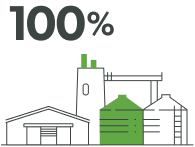
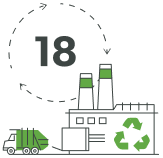

GOALS AND TARGETS

Dive into the Report
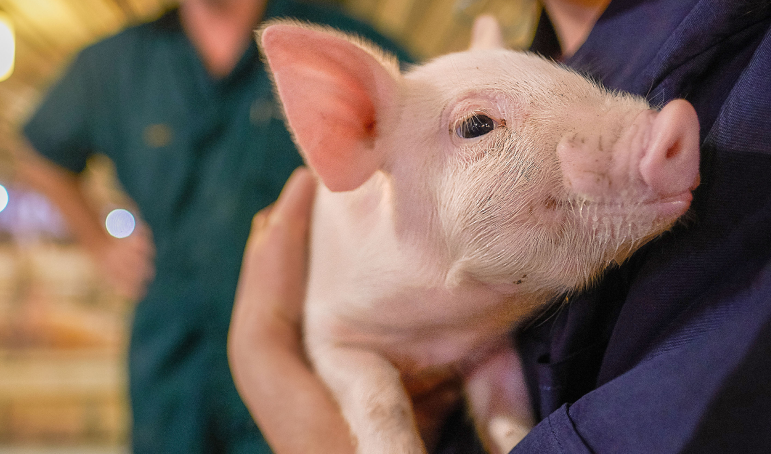
We maintain a steadfast commitment to the safety, health and comfort of our animals. We pioneer and follow industry best practices to prevent animal disease, ensure a biosecure environment for our animals and provide safe, comfortable housing through every stage of our animals’ lives.

At Smithfield, food safety and quality are more than a set of standards to meet. They are ingrained in our culture and touch every Smithfield employee—from our farms to our corporate offices.
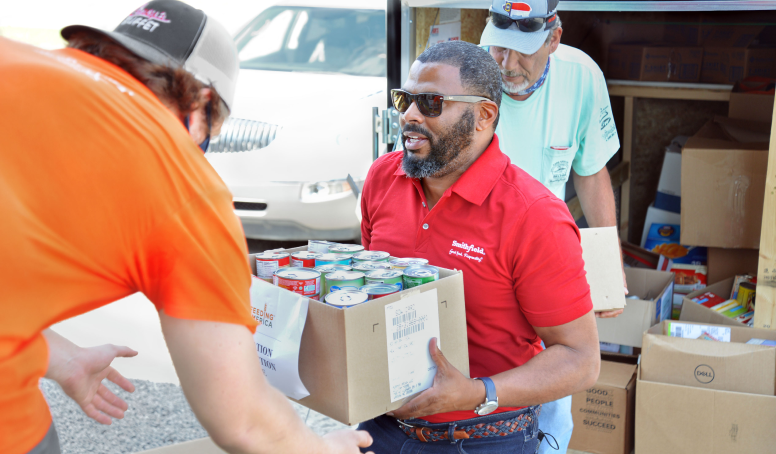
We have a great responsibility to support the communities we call home. Through targeted philanthropy and volunteerism, we aspire to make a meaningful impact that addresses food insecurity, advances education and supports the vitality of our local communities.
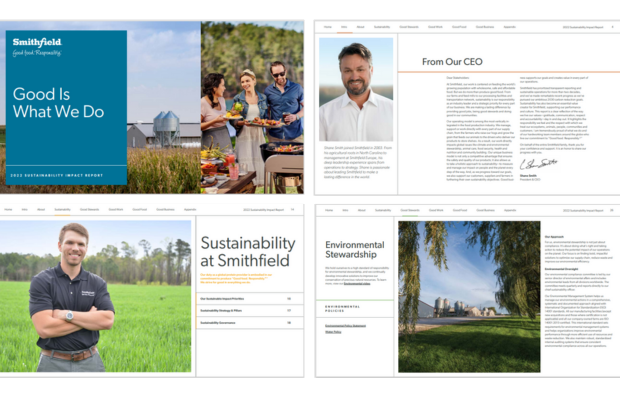
Download the 2022 Report
Download the report